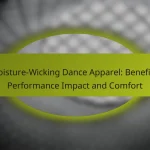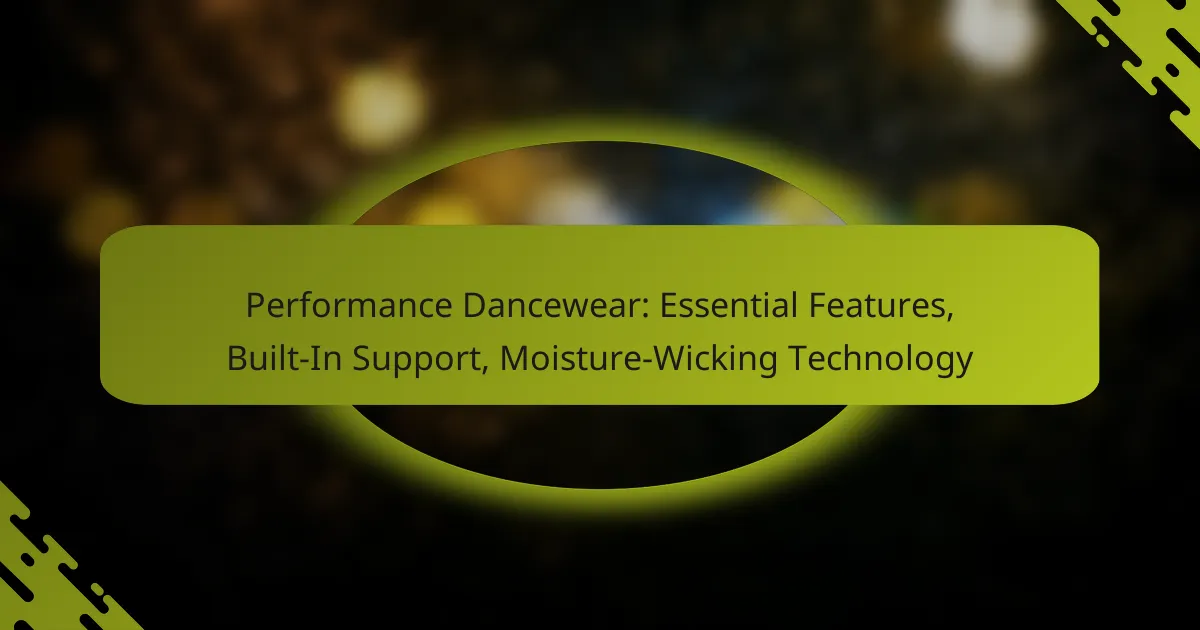Performance dancewear is crafted to elevate a dancer’s experience by incorporating essential features such as durability, breathability, and flexibility. With built-in support to ensure freedom of movement and moisture-wicking technology to keep dancers dry, these garments allow for optimal performance and comfort during routines. Additionally, a variety of styles and fits cater to different body types, making it easier for dancers to find the perfect outfit for their needs.

What are the essential features of performance dancewear?
Performance dancewear is designed to enhance a dancer’s experience through specific features that support movement, comfort, and durability. Key elements include durability, breathability, flexibility, style, and a variety of size and fit options to accommodate different body types.
Durability for rigorous use
Durability is crucial for performance dancewear, as it must withstand the demands of rigorous training and performances. Look for materials like nylon or spandex blends that offer resilience against wear and tear. High-quality stitching and reinforced seams can also enhance the longevity of the garments.
When selecting dancewear, consider options that are specifically labeled as performance-grade, as these are often tested for durability under intense conditions. Regularly inspect your gear for signs of fraying or damage to ensure it remains safe and effective.
Breathability for comfort
Breathability is essential in dancewear to keep dancers comfortable during practice and performances. Fabrics with moisture-wicking technology help draw sweat away from the body, promoting airflow and reducing overheating. Look for mesh panels or lightweight materials that enhance ventilation.
Choosing breathable dancewear can significantly improve performance, as it allows for greater focus and less distraction from discomfort. Fabrics that dry quickly are also beneficial, especially in humid environments or during intense sessions.
Flexibility for movement
Flexibility is a key feature of performance dancewear, allowing for a full range of motion. Stretchy materials like spandex or elastane enable garments to move with the body, preventing restrictions during complex movements. This flexibility is vital for executing various dance styles effectively.
When trying on dancewear, perform a few movements, such as lunges or jumps, to ensure the fit allows for freedom of motion. Avoid overly tight garments that may hinder performance or cause discomfort.
Style and aesthetics
Style and aesthetics play a significant role in dancewear, as dancers often want to express their individuality. Performance dancewear comes in various colors, patterns, and designs, allowing dancers to choose outfits that reflect their personal style and the character of their performances.
Consider the visual impact of your dancewear, especially for performances. Outfits that complement choreography and enhance stage presence can contribute to a more engaging performance. However, ensure that style does not compromise functionality.
Size and fit options
Size and fit options are critical for ensuring comfort and performance in dancewear. Many brands offer a range of sizes, including plus sizes, to accommodate different body shapes. It’s essential to refer to size charts and consider trying on multiple sizes to find the best fit.
Pay attention to the cut of the garments, as some styles may be designed for specific body types. A well-fitting outfit should feel snug but not restrictive, allowing for ease of movement while providing adequate support.

How does built-in support enhance performance?
Built-in support in performance dancewear significantly enhances a dancer’s ability to move freely and confidently. This feature minimizes distractions caused by discomfort or improper fit, allowing dancers to focus on their routines and maintain optimal performance levels.
Supportive bras for dancers
Supportive bras are essential for dancers as they provide the necessary lift and stability during movement. These bras are designed to accommodate a range of body types and dance styles, ensuring that dancers can perform without worrying about their support. Look for bras with adjustable straps and wide bands for a customized fit.
When selecting a supportive bra, consider materials that offer both comfort and durability. Fabrics like nylon and spandex blend provide flexibility while maintaining shape, which is crucial during intense routines.
Compression technology benefits
Compression technology enhances performance by providing targeted support to key muscle groups. This feature helps reduce muscle vibration and fatigue, allowing dancers to maintain their energy levels throughout practice or performance. Compression garments can also improve blood circulation, which aids in recovery.
For optimal benefits, choose compression wear that fits snugly but is not overly restrictive. Look for items labeled with specific compression ratings to ensure they meet your performance needs.
Stability in high-impact routines
Stability is crucial during high-impact dance routines, as it helps prevent injuries and enhances overall performance. Dancewear with built-in support features, such as reinforced seams and structured panels, can provide the necessary stability for jumps and quick movements.
To ensure maximum stability, select dancewear that has been tested for high-impact activities. Look for garments that offer a combination of flexibility and firmness, allowing for both movement and support during demanding performances.

What moisture-wicking technologies are used in dancewear?
Moisture-wicking technologies in dancewear are designed to draw sweat away from the body, keeping dancers dry and comfortable during performances. These fabrics typically feature specialized fibers that facilitate evaporation, enhancing overall performance and comfort.
Types of moisture-wicking fabrics
Common types of moisture-wicking fabrics include polyester, nylon, and blends that incorporate spandex for stretch. Polyester is particularly popular due to its lightweight nature and quick-drying properties. Nylon offers durability and a soft feel, while spandex adds flexibility, allowing for a full range of motion.
Some advanced options include fabrics treated with hydrophilic finishes that enhance moisture absorption and evaporation. This technology can significantly improve comfort levels during intense dance routines.
Benefits of moisture management
Effective moisture management in dancewear provides several key benefits. It helps regulate body temperature, reducing the risk of overheating during performances. Additionally, moisture-wicking fabrics minimize chafing and irritation, allowing dancers to focus on their movements without distraction.
Moreover, these fabrics can contribute to improved hygiene by reducing the growth of odor-causing bacteria. This is particularly important for dancers who often wear tight-fitting clothing for extended periods.
Popular brands using this technology
Many well-known brands incorporate moisture-wicking technology into their dancewear lines. Brands like Capezio and Bloch are recognized for their high-quality dance apparel that effectively manages moisture. Additionally, Lululemon and Nike offer stylish options that combine performance with aesthetic appeal.
When selecting dancewear, consider brands that specifically highlight moisture-wicking features in their product descriptions, ensuring you choose garments that enhance your performance and comfort on stage.

What are the best brands for performance dancewear?
The best brands for performance dancewear include Bloch, Capezio, and Gaynor Minden. Each brand offers unique features, styles, and innovations that cater to dancers’ needs, ensuring comfort and functionality during performances.
Bloch for quality and variety
Bloch is renowned for its extensive range of dancewear that combines quality and variety. From ballet to contemporary styles, their offerings include leotards, tights, and shoes made from durable materials that withstand rigorous use.
When choosing Bloch products, consider the fit and fabric. Their moisture-wicking technology helps keep dancers dry, while built-in support features enhance comfort during performances. Popular items include the Bloch “Sophie” leotard and “Prolite” ballet shoes.
Capezio for classic styles
Capezio is a staple in the dance community, known for its classic styles and timeless designs. Their dancewear often features elegant cuts and high-quality fabrics that appeal to both professional and amateur dancers alike.
Look for Capezio’s signature leotards and tights, which provide excellent support and flexibility. The brand’s commitment to tradition ensures that their products remain popular among dancers who appreciate classic aesthetics.
Gaynor Minden for innovation
Gaynor Minden stands out for its innovative approach to dancewear, particularly in pointe shoes. Their products incorporate advanced materials and technology to enhance performance and comfort.
Consider Gaynor Minden’s pointe shoes, which feature a unique design that allows for better balance and support. The brand’s commitment to research and development means that dancers can expect cutting-edge solutions to common performance challenges.

How to choose the right dancewear for different styles?
Selecting the right dancewear involves understanding the specific requirements of each dance style. Key features to consider include fit, flexibility, support, and moisture-wicking technology to enhance performance and comfort.
Considerations for ballet
Ballet dancewear typically emphasizes elegance and form. Look for leotards that offer a snug fit and support, allowing for a full range of motion while maintaining a streamlined silhouette.
Materials should be breathable and stretchy, such as cotton blends or spandex, to facilitate movement. Consider layering with tights or skirts that complement the leotard and enhance the aesthetic.
Choosing for contemporary dance
Contemporary dancewear prioritizes comfort and versatility. Opt for loose-fitting tops and bottoms that allow for fluid movement, such as tank tops paired with leggings or flowy pants.
Moisture-wicking fabrics are essential to keep dancers dry during intense practice sessions. Look for options that provide both style and functionality, allowing for personal expression while meeting performance needs.
Options for jazz and hip-hop
Jazz and hip-hop dancewear often features a mix of fitted and loose styles. For jazz, consider form-fitting attire like bodysuits or fitted tops with jazz pants that allow for dynamic movement.
In hip-hop, baggy clothing is popular, so choose oversized tees and joggers that provide comfort and freedom. Ensure the materials are durable and breathable, as these styles often involve high-energy movements.










